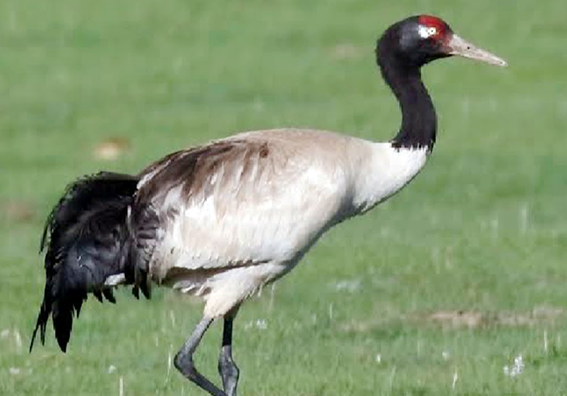Black-Necked Crane | 24 Feb 2021
Why in News
Recently, a group of Buddhist monks in Tawang district has opposed the Arunachal Pradesh government’s renewed push for hydropower projects.
- The proposed projects would not only affect the nesting grounds of the endangered Black-Necked Crane but also threaten several holy Buddhist pilgrimage sites in the region.
Key Points
- About:

- Both the sexes are almost of the same size but male is slightly bigger than female.
- The upper long neck, head, primary and secondary flight feathers and tail are completely black and body plumage is pale gray/whitish.
- A conspicuous red crown adorns the head.
- The juveniles have a brownish head and neck and plumage is slightly paler than that of an adult.
- Special Significance:
- The bird is revered by the community of Monpas (major Buddhist ethnic group of Arunachal Pradesh) as an embodiment of the sixth Dalai Lama (Tsangyang Gyatso).
- Monpas inhabit the West Kameng and Tawang districts, are essentially Buddhists who follow the Mahayana sect.
- The bird is revered by the community of Monpas (major Buddhist ethnic group of Arunachal Pradesh) as an embodiment of the sixth Dalai Lama (Tsangyang Gyatso).
- Habitat and Breeding Grounds :
- The high altitude wetlands of the Tibetan plateau , Sichuan (China), and eastern Ladakh (India) are the main breeding ground of the species, the birds spend winter at lower altitudes.
- In Bhutan and Arunachal Pradesh, it only comes during the winters.
- In Arunachal Pradesh, it can be seen in three areas:
- Sangti valley in West Kameng district.
- Zemithang in Tawang district.
- Chug valley in Tawang district.
- Threats:
- Damage to the eggs and chicks, caused by feral dogs.
- Loss of habitat due to human pressure (Development Projects) on the wetlands.
- Increased grazing pressure on the limited pastures near the wetlands.
- Steps for their Conservation:
- World Wide Fund for Nature-India (WWF-India) in collaboration with the Department of Wildlife Protection, Jammu & Kashmir, has been working towards conservation of high altitude wetlands, with black-necked cranes as a priority species in Ladakh region.
- In Arunachal Pradesh, WWF is working for the conservation of the small wintering population.
- World Wide Fund for Nature-India (WWF-India) in collaboration with the Department of Wildlife Protection, Jammu & Kashmir, has been working towards conservation of high altitude wetlands, with black-necked cranes as a priority species in Ladakh region.
- Protection Status:
- IUCN Red List: Near Threatened
- CITES: Appendix I
- Indian Wildlife (Protection) Act, 1972: Schedule I
